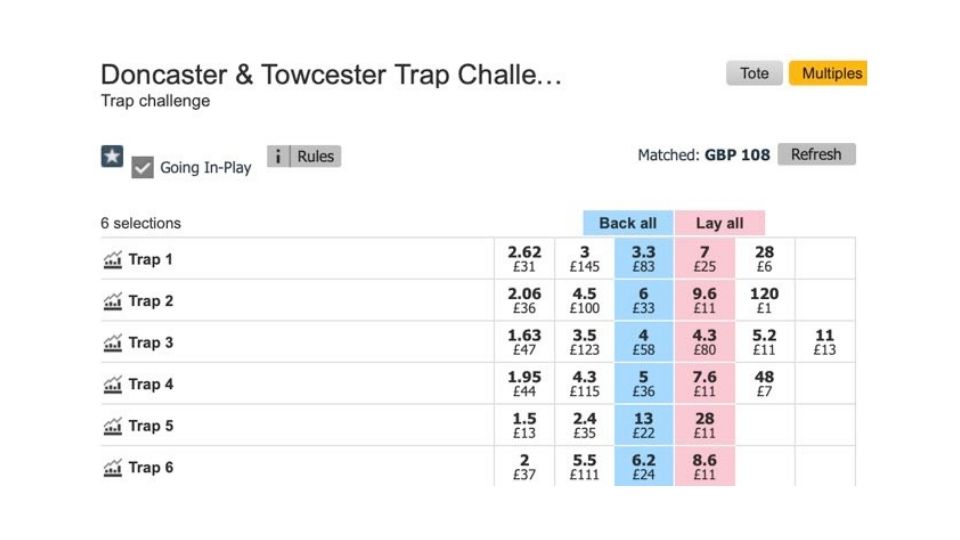The Greyhound Racing Trap Challenge is classified as one of the more engaging forms of betting, offering a unique and in-depth test of a punter’s knowledge and luck.
Understanding the Trap Challenge
At its core, the Trap Challenge is a bet where the wager is placed on a specific ‘trap’ which signifies a starting position in greyhound races. The gambler aims to correctly predict which ‘trap’ will yield the most winners throughout a event.
Determining Your Bet: Factors to Consider
When deciding on your bet in a trap challenge, various factors could influence your decision:
Track Knowledge: Such factors could include knowing if a specific track has historical data that shows bias towards dogs starting from lower or higher numbered traps.
Form and Draw: If one has a deep understanding of the form and draw of the dogs involved in the race, it could significantly increase the chances of making an accurate prediction. The perceived speed of the dogs based on their past performance, and their position in the trap can play a crucial role.
Pure Luck: For some, simply selecting a trap based on a random number between one to six and leaving the result up to pure chance might be the preferred approach.
The Adventurous Approach: Combining Two Tracks
For bettors seeking a more adventurous approach, the Trap Challenge allows for the combination of two different racing tracks. The aim is to predict which trap will come out on top at both venues. The permutation adds an additional layer of excitement and potential reward.
Ways to Make Your Selection
Your selection for the trap challenge can be made in numerous ways. Here are some common methods adopted by both novice and experienced bettors:
Studying the Form: You could study the form of the participating greyhounds meticulously to make an informed choice.
Following the track trends: Keeping tabs on the track trends, and understanding which traps tend to yield the most winners, can be another useful strategy.
Random Guesswork: Sometimes, an uninformed guess or hunch could just as well turn out to be successful.
The Trap Challenge offers a versatile betting system with options that can cater to a variety of tact, skill and luck. Its complexity and the factors at play serve to make it one of the most thrilling ways to participate in greyhound racing betting.
The Rules of Trap Challenge Betting
Trap Challenge Betting operates under a set of clear and concise rules primarily centered on the simple principle of numerical dominance. The trap with the highest number of wins in a race day or evening is declared the victor, and bets are settled accordingly.
Special Conditions in Trap Challenge Betting
Certain unique situations may complicate the straightforward process. These challenges and their general outcomes are described below:
Equal Winners at a Meeting: In the circumstance that two traps record an equal number of wins at a meeting, then the dead heat rules come into play. The specific ramifications can vary based on the bookmaker’s policies. Most commonly, half of the bet stake is treated as a win at the odds agreed upon at the time of the bet, and the other half is treated as a loss.
Race Ends in Dead Heat: If a race ends in a deadlock, a different procedure is used. Both victorious traps are awarded half a point each, and the calculation continues accordingly in the regular fashion.
Key Factors to Consider in Trap Challenge Betting
When engaging in Trap Challenge Betting, it’s crucial to consider a few key elements:
Bookmaker’s Policies: Understanding the specific rules and policies of your bookmaker can help navigate the complexities of specific situations.
Frequency of Dead Heats: The regularity of dead heat races at a specific venue or meeting might influence your strategy and risk management.
Preliminary Observations and Potential Bias in Greyhound Racing
Ever since greyhound races have become a popular sport across multiple countries, certain unconfirmed claims suggest track biases based on position, insinuating what is known as a “trap bias.” These sentiments are generally derived from broad anecdotes and lores, often referred to as old wives’ tales. Nevertheless, the solidity of these tales can be ascertained by examining real-time data sourced from reliable websites like GreyhoundStats.co.uk, specializing in statistical information for greyhound racing.
Trap Bias Analysis using Statistical Data
Websites like GreyhoundStats.co.uk offer an opportunity for bias detection within tracks. The website encompasses a vast range of data from tracks spread across multiple locations. A comprehensive study of such data reveals interesting insights.
Uniformity Across Tracks: One decisive observation is the relative uniformity prevalent across all tracks, dismissing the appearance of pronounced biases. Deviations amount to only a few percentage points, providing no substantial evidence for widespread trap biases.
Large Sample Size Findings: Despite the broad consensus, large data samples can sometimes reveal patterns hinting at potential bias. For instance, over 2,800 races from Hove have shown that trap one has a 19.9% win rate, significantly higher than trap five’s 13.6% win rate. This data could lend support to the existence of a certain bias within the Hove track, favoring dogs on the inside.
The “Eye Test” in Extreme Conditions
In addition to the statistical analysis, personal observation or the so-called “‘eye test'” can be an alternate evaluative tool, particularly useful during extreme weather conditions such as heavy rains or intense heat.
Weather-induced Variation: Extreme weather condition might cause one side of the racetrack to differ from the other, impacting the performance of the dogs. For example, a non-uniformly draining track could lead to heavier ground conditions for dogs running on one side.
Importance of Personal Observation: The ‘eye test’ allows for an intuitive interpretation of the race conditions, supplementing the understanding of potential biases not explicitly apparent in the statistical data.
In summary, while historical claims and anecdotes hint at potential biases in greyhound tracks, statistical data and individual observation serve as more reliable sources for understanding the reality of trap biases in the world of greyhound racing.
Greyhound Betting Strategies
Successful trap challenge betting often requires a combination of past trap data, race-by-race research, and intuition. There are several approaches and tactics that can be employed to increase the chances of success.
Timing of Trap Challenge Bets
One key strategy is to place trap challenge bets as late as possible before the start of a meeting. This helps bettors in multiple ways:
Non-runners Reporting: Greyhound racing has comparatively substandard non-runner reporting as opposed to horse racing. Placing bets later ensures the bettor is better informed and can make decisions based on the most accurate information.
Maximizing Winning Chances: By accounting for non-runners and ensuring that the chosen trap is fully stocked for every race, the bettor can increase the likelihood of success.
Dutching Strategy
Dutching is a betting tactic that involves hedging bets by backing multiple traps at the same meeting. This method has several advantages:
Risk Spread: With Dutching, bettors can spread their risk across multiple traps, reducing the chance of losing.
Diluted Returns: While returns may be lower than backing a single trap, the probability of winning increases by covering more than one trap.
Stake Distribution: A bettor may choose to split stakes evenly across two traps (50% on each) or vary the stakes proportionally according to their confidence (e.g., 75% on one trap and 25% on the other).
Considering each of the six standard trap options represents around a 16.5% chance of winning, Dutching demonstrates a plausible tactic for savvy bettors in greyhound racing.




